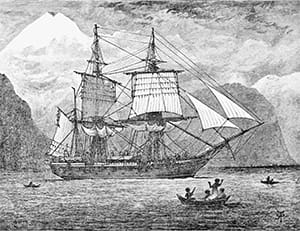Although mostly now remembered as the captain of HMS Beagle in her five-year voyage around the world with a young Charles Darwin, Robert FitzRoy was a man of the scientific age who made contributions in many fields. A renowned surveyor, FitzRoy was also a meteorologist of great imagination and skill. He was responsible for founding the British Met Office, and persuaded the Admiralty to place barometers on Royal Navy ships so that captains could foresee changing weather situations. So exacting were his methods that FitzRoy carried at least 22 chronometers.
Essential to finding longitude, accurate timepieces were important in establishing the position of unknown places on the Earth. Each of Beagle’s chronometers was treated with great care. They were mounted in their own gimbaled box and stored in sawdust.
So successful was FitzRoy with his survey that he established reference longitudes all over the world that were employed by later captains to calibrate their own chronometers.
FitzRoy measured the overall accuracy of his voyage by using his chronometers to measure the time of local noon. When he returned home, he found that he was off by 33 seconds or about 8.25 nautical miles, which is pretty amazing on a voyage of many thousands of miles. Yet such a stickler was FitzRoy that he considered the error large.
When FitzRoy was captain of Beagle, he was very much a student of Charles Lyell, the geologist who pointed the way toward Darwin’s evolutionary theories. And, in fact, it was FitzRoy who introduced Darwin to the writings of Lyell.
Darwin was FitzRoy’s cabinmate for the five years it took Beagle to circumnavigate. FitzRoy wanted to have a companion that he could discuss intellectual topics with and Darwin paid 200 pounds for that privilege.
When Darwin’s Voyage of the Beagle was published in 1839, FitzRoy, once a great supporter of the scientific method postulated by Lyell, took refuge in the Bible as the source of the creation story. He strenuously disavowed the theories of Darwin.
He was a complicated man of aristocratic birth, a superior mariner and an able administrator, but also a conflicted man who suffered from debilitating bouts of depression. His depression became so severe that he took his own life when he was 59 years old in 1865. A sad end to a man who contributed so much to science and navigation.
Let’s join Capt. FitzRoy aboard Beagle on the way to the Galapagos Islands. It is Feb. 25, and we will be using the 2017 Nautical Almanac. FitzRoy is taking a lower limb sun sight to establish a Line of Position. The height of eye is 20 feet and the time of the observation is at 15:35:25 GMT. The DR at the time is 0° 30’ S by 89° 50’ W. The Hs is 49° 53.8.’
A. What is the Ho?
B. What is the LHA at the time of the sight?
C. What is the intercept?
Answers
A. Ho is 50° 04.9’
B. LHA is 321°
C. Intercept is 4.1 nm away, bearing 103°

